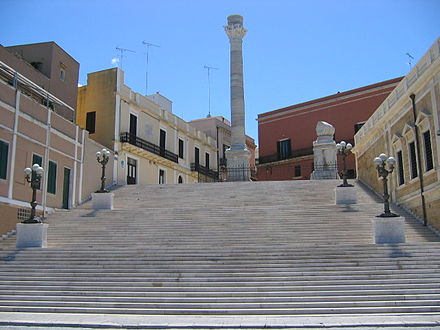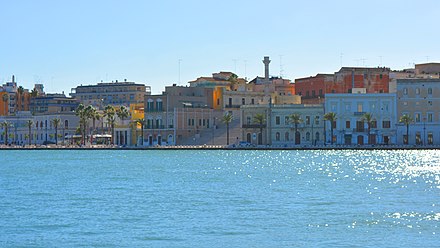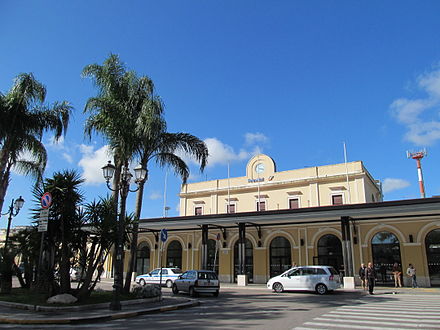Brindisi - Italian comune
Brindisi (Salentino: Brìnnisi) is a medium-sized city of Apulia, southern Italy. It is the third largest city of Salento Peninsula (the "heel" of the Italian "boot") and one of the busiest ports of the Adriatic Sea.
Understand
History
 The city was founded by the Messapians, a population of Illyrian origin, with the name of Brunda, meaning "deer's head". This name is due to the natural harbor which resembles the shape of the animal's antlers. The city assumed the name of Brention and then Brentèsion in Ancient Greek, to be later called Brundisium after the conquest by the Romans in 267 BC.
The city was founded by the Messapians, a population of Illyrian origin, with the name of Brunda, meaning "deer's head". This name is due to the natural harbor which resembles the shape of the animal's antlers. The city assumed the name of Brention and then Brentèsion in Ancient Greek, to be later called Brundisium after the conquest by the Romans in 267 BC.
Brundisium reached a population of 100,000 and became the main commercial port of the Roman Empire, with heavy traffic towards Greece and the Middle East that continues today. The city was connected with Rome by the Via Traiana and the Via Appia, whose terminus is still visible today. Virgil died here on September 21 of 19 BC, after a voyage to Greece, where he caught a fever.
Brindisi's golden age ended in the early Middle Ages with invasions by the Ostrogoths, Lombards and Saracens that destroyed the city several times. It was later rebuilt and annexed by the Normans to the Kingdom of Sicily in 1130 and became one the major ports for the Crusaders headed to Holy Land. The town was dominated by Swabian, Angevin, Aragonese, Venetian, Spanish and Austrian kingdoms, and then ruled by the Bourbons from 1735 to 1860.
After Italian unification — and especially with the opening of the Suez Canal in 1869 — a new positive period started for Brindisi. Between September 1943 and February 1944 the city functioned as the temporary government seat of Italy, and hosted King Victor Emmanuel III, Pietro Badoglio and a part of the Italian armed forces command in September 1943 after the armistice with Italy.
Climate
Brindisi enjoys a Mediterranean climate. Summers are hot and sometimes humid with abundant sunshine. During spring and autumn, Sirocco winds can bring thunderstorms, occasionally dropping red sand from the Sahara in the region. Winters are mild with frequent rain; snow is quite rare.
Get in
By plane
- Brindisi Airport (IATA: BDS known as Aeroporto del Salento), Contrada Baroncino, 40.658056°, 17.946667°, +39 0831 411 7406. Is served by TuiFly, AirOne, ITA Airways and Ryanair. 2018-06-08 The companies that provide a car-rental service from the airport are:
- Autoeuropa, +39 0831 412589, brindisiapt@sbc.it. 08:00-23:00.
- Autovia, +39 0831 412672, brindisi@autovia.it.
- Avis, +39 0831 418826, customer.service@avis-autonoleggio.it. 08:00-23:30.
- Budget, +39 0831 418826, it.reservations@budget-emea.com. 08:00-23:30.
- Europcar, +39 0831 412061. 08:00-23:00.
- Hertz, +39 0831 182 2843. 08:00-23:00.
- Locauto, +39 0831 412882. 08:00-23:00.
- Leasys, +39 0831 217482. 08:00-22:00. 2021-08-09
By boat
 Ferries to Brindisi are available from Greece (Corfu, Igoumenitsa, Cephalonia, Zante, Patras) and Turkey (Cesme). Visit www.Ferries.gr and search through all ferry schedules to/from Brindisi.
Ferries to Brindisi are available from Greece (Corfu, Igoumenitsa, Cephalonia, Zante, Patras) and Turkey (Cesme). Visit www.Ferries.gr and search through all ferry schedules to/from Brindisi.
Also Albania is well connected to the city, with ferries from Vlore, managed by Skenderbeg Lines.
To get to the ferry terminal, a regular bus runs from the front entrance of the railway station.
Apart from being a ferry port Brindisi is also home to the United Nations logistics base (UNLB). The base provides resources logistic support, telecommunications and training opportunity for all peacekeeping operations around the world.
By train
The main cities of northern Italy are not directly connected to this station and a change in Bologna will be necessary. Here you can take a Frecciabianca train to reach Brindisi in 6¾ hours, with a cost comprised between €40 and €60. From Taranto it is possible to take a regional train to arrive in the town in 1¼ hr spending €5. From Lecce you can choose between regional trains, that take about ½ hr (€2.8) or Frecciabianca (€9.9), reaching Brindisi in just 15 minutes. Visit the site of Trenitalia for more info.
- Brindisi railway station (Stazione di Brindisi Centrale), Piazza Francesco Crispi (End of Corso Umberto I and close to Piazza Cairoli.). 2023-03-13
By car
If you want to reach Brindisi from north the best option is driving along the motorway until the exit of Bari Nord, here merge onto the expressway
to bypass the centre of Bari and reached Fasano continue on
. The route from Bari requires 1 hour.
-
From Naples take the
motorway that ends in Canosa and
until Bari, then following the route described above. (3½ hr) Alternatively you can choose to cross the Basilicata region through
and
motorways until Potenza, then
Basentana,
until Taranto and finally
to Brindisi (4 hr). Both the routes are 370 km (230 miles) long, but the first one will require a cost of €20, while the latter only €5.
-
From Lecce drive along the
freeway for ½ hr.
Get around
By car
Surrounding areas, such as beaches to the north, are best reached by car.
On foot
As the city center area is not so large, a bit over a kilometer from the train station to the Roman Columns, most of the sights in the city center can be seen in an afternoon on foot. Because of many military facilities in the surroundings of Brindisi, areas north or south of the city center are not easy (or very pleasant) to reach on foot. For most things outside of the center, it is better to take a bus or rent a car.
See
- Monumento al Marinaio d'Italia (Monument to the Italian Sailor), Viale Duca degli Abruzzi, 40.644426°, 17.947138°. 09:00-13:00/16:20-19:00; closed on Thursday. A tribute to the 6,000 Italian sailors died in WWI, built in 1933. It is 53 meters (174 ft) high and it has the shape of a rudder, made in reinforced concrete and clad with limestone rock. You can visit the crypt or climb an helical stairway to reach its top, where it is possible to admire the view over the whole city and its harbor. Free entry 2018-07-09
- Roman columns (Colonne romane), Via Colonne, 53, 40.641143°, 17.946825°. A symbol of Brindisi, they were thought to mark the termination of the Appian Way, but probably they only had a celebrative purpose. Only one of the two, standing at 18.74 meters (61.5 ft), is still visible, since the other one crumbled in 1528, and the ruins were donated to the city of Lecce to hold the statue of its patron Saint Oronzo. They were built during the 2nd century AD, with a Corinthian capital. 2018-07-09
- Santa Maria del Casale, Contrada Baroncino (just beside the airport), 40.654253°, 17.934913°, +39 0831 412668. 08:00-20:00. Church completed in 1322, in Gothic-Romanesque style. The facade has a geometrical pattern of gray and yellow stones, with an entrance cusp-covered portico. The interior has 14th century frescoes in late-Byzantine style. Due to its artistic relevance, in 1875 it was declared as National Italian Monument. Free entry 2018-07-09
- Church of San Benedetto, Via Guglielmo Marconi, 2, 40.638222°, 17.941°, +39 0831 597474. Romanesque church of the 10th century, with a massive bell tower with triple-mullioned windows and Lombard bands. A side portal is decorated with 11th century motifs, while the interior has a nave covered by cross vaults, while the aisles, separated by columns with Romanesque capitals, have half-barrel vaults. Noteworthy is the cloister, with marble columns and a 13th century fresco. Free entry 2018-07-09
- Temple of San Giovanni al Sepolcro, Piazza San Giovanni al Sepolcro, 40.6388°, 17.943°. 08:00-20:00. Circular Romanesque church built by the Normans in the 11th century; it was probably owned by the Knights of the Holy Sepulchre. The interior has the shape of a "horse shoe" with eight columns in concentric circle within. The 12th century portal has an architrave made from marble, which is supported by two columns that rest on two lions made from marble as well. Despite its small size it is one of the most relevant Romanesque churches of southern Italy. Free entry 2018-07-09
- Cathedral (Basilica Cattedrale), Piazza Duomo, 12, 40.6404°, 17.9458°, +39 0831 521157, cattedralebrindisi@gmail.com. 09:00-12:00/18:00-20:00. Romanesque structure dedicated to St. John's the Baptist, built between 1098 and 1132. It has been almost entirely rebuilt, following the original design, after the earthquake in 1743. Inside it is possible to admire a polychrome mosaic from 1178 and a crown in wood from 1594. Free entry 2018-07-09
Do
Buy
For fruits and vegetables, there is a market area in the city center at the appropriately named "Piazza mercato", open every day except Saturday.
There are many clothing and specialty shops in the center.
During the off-season, many shops will close for a period in the early afternoon (around 1PM to 4PM), similar to the midday closures for siesta in many parts of Spain. This is also the case for many other cities in the region.
Eat
Restaurants will have many common items of Apulian cuisine. Famous pasta styles include spaghetti alle vongole and orechiette con cime di rapa.
Locals speak highly of the seafood in the area.
Budget
All these are in the city centre:
- Pizzeria La Piazzetta, Piazza Mercato, 3, 40.6374492°, 17.9447454°. 2022-05-01
- Il Botteghino Pizzeria, Corso Roma, 35, 40.6360234°, 17.9449506°. 2022-05-01
- La Cantina ti l'Artisti, Via De' Terribile, 11, 40.6382781°, 17.9463625°. Down home cooking 2022-05-01
- Urban Beat Burger & Coffee, Corso Giuseppe Garibaldi, 76, 40.6384929°, 17.9474568°. 2022-05-01
- Locanda degli Schiavoni, Via Giovanni Tarantini, 41, 40.6397001°, 17.9434539°. A pizza restaurant 2022-05-01
- Ristorante gusto, Via Palestro, 16, 40.6364676°, 17.9418617°. 2022-05-01
- Ristorante pizzeria Bella Napoli, Via Montenegro, 53, 40.6416369°, 17.9445724°. 2022-05-01
Mid-range
- Don Angus, Vicolo Guerrieri, 16, 40.6403613°, 17.9468171°. Exceptional and refined meat. Very quiet place. Professional and friendly staff. 2022-08-01
- La Locanda del Porto, Via Montenegro, 20, 40.6413125°, 17.9447270°. Excellent restaurant, impeccable fish quality. Fresh products, top service and really good food. 2022-08-01
Splurge
- Ristorante Acquapazza, Piazza Dante, 5, 40.6398112°, 17.9429715°. 2022-08-01
Drink
Sleep
- Masseria Incantalupi, Strada Provinciale, 7 Vecchia Monopoli, +39 0831 555990. Farmhouse accommodation near Brindisi with pool, horse riding center and organic food production.
- The Youth Hostel, Via Nicola, Brandi N.2, +39 338 323 5545. Picks you up from the train station and drops you in the ferry embarkation place for free. You can have day-time beds as well for a very reasonable price. The staff are very friendly and helpful.
- Malvasia Bed and Breakfast, Vico Scalese, 8 - 72100 Brindisi (Historical centre), +39 349 380 0689, carbonaraornella@gmail.com. 2015-06-09
Go next
If you have not bought the ferry ticket online, you can buy it from an office very close to the train station (exact address required). They will also give you a map to find the embarkation place for ferries. Remember to show your EU-rail pass, if you have any, to get a discount. They will also call Youth Hostel to pick you up if you arrive in the morning and want to leave in the afternoon or you want to stay over the night.
Brindisi
comune.brindisi.itProvince of Brindisi
2nd-order administrative division
Apulia
Primary administrative division

